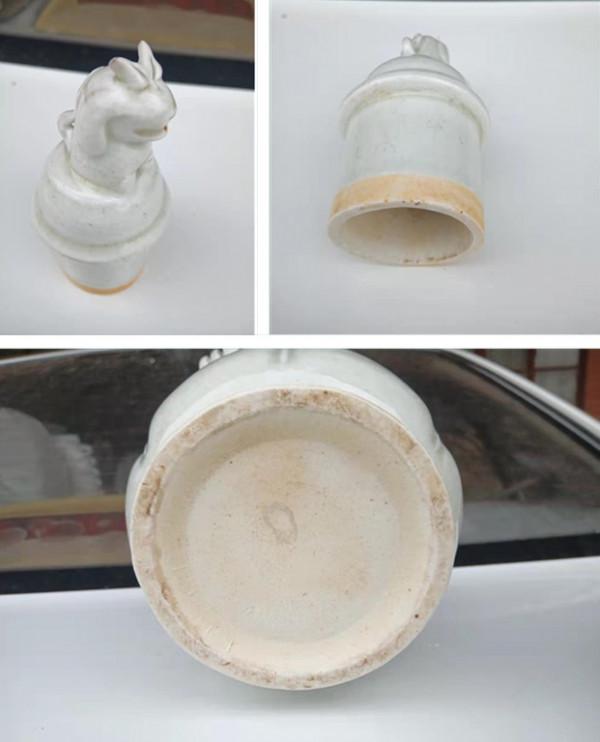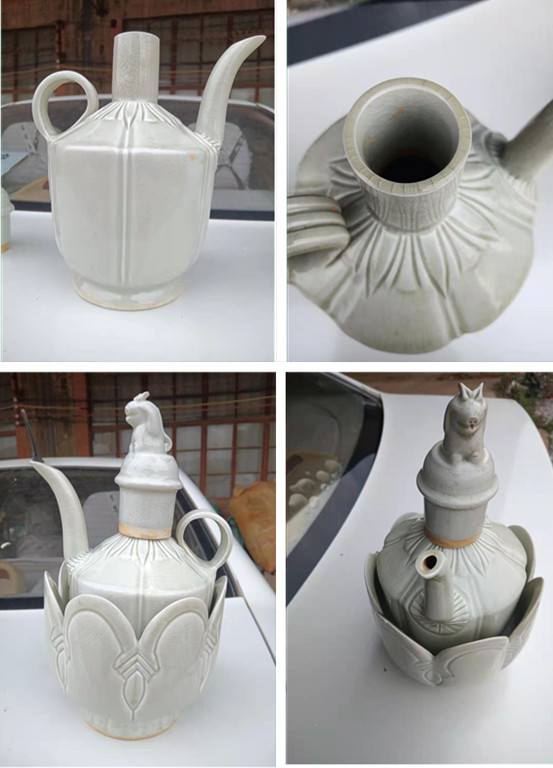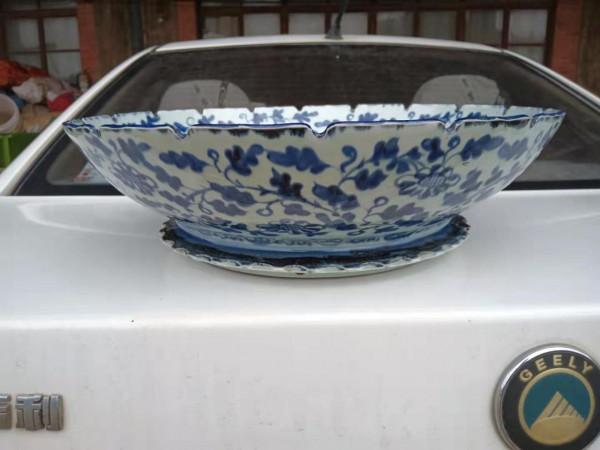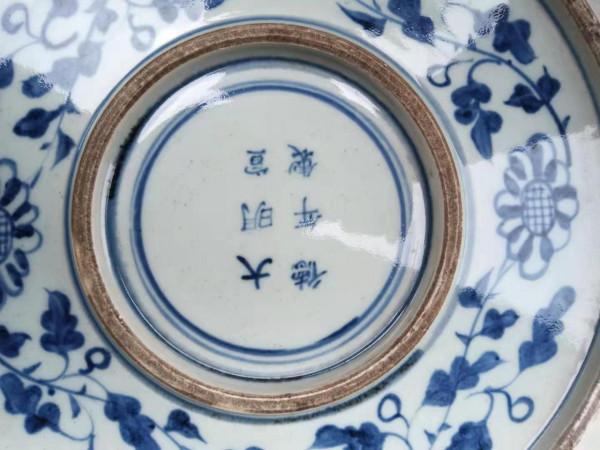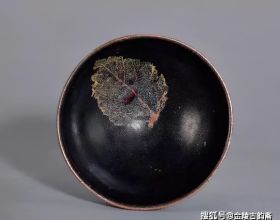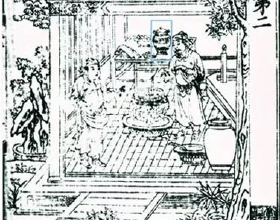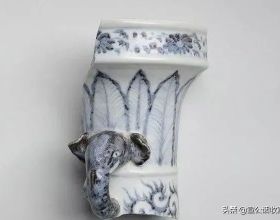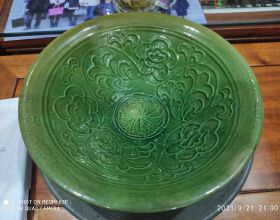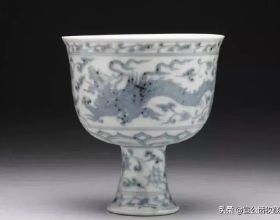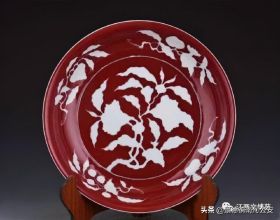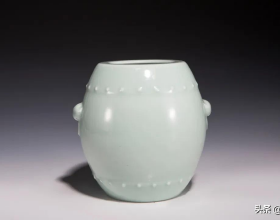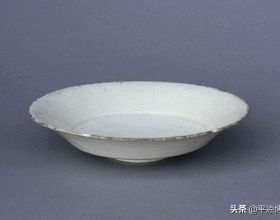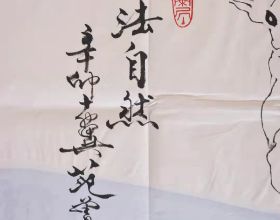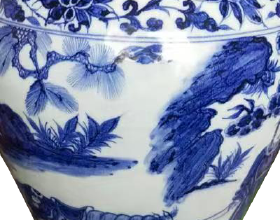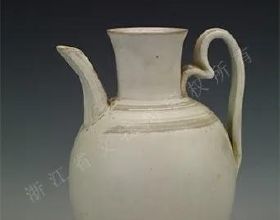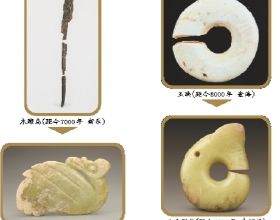定窯是中國傳統制瓷工藝中的珍品,宋代六大窯系之一,它是繼唐代的邢窯白瓷之後興起的一大瓷窯體系。主要產地在今河北省保定市曲陽縣(原屬今定州市)的澗磁村、野北村及東燕川村、西燕川村一帶,因該地區唐宋時期屬定州管轄,故名定窯。
定窯原為民窯,北宋中後期開始燒造宮廷用瓷。創燒於唐,極盛於北宋及金,終於元,以產白瓷著稱,兼燒黑釉、醬釉和綠釉瓷,文獻分別稱其為"黑定"、"紫定"和"綠定"。
定窯從邢窯而來,由於歷史的變遷,定窯隨著地域變化,新瓷土料的運用和制瓷工藝的進步。卞向和認為:定窯最大的貢獻就是在中國陶瓷發展的歷史上閃爍過光芒,在中國陶瓷史和世界的陶瓷發展史上留下輝煌的一頁。
定窯蓮座執壺
定窯,是中國北方白瓷的中心,始於唐,為邢窯的後繼者,在五代時期就已經發達。以往文獻多記載窯址在河北正定,1938年在河北省曲陽縣澗瓷村發現古窯址。近年又多次發掘調查,發現了最下層堆積著晚唐的破片;中層的是五代時就已大量生產;最上層為印花、畫花的薄瓷片,是屬於北宋中期以後,在政和、宣和年間。這些薄瓷片,胎質堅緻,釉澤瑩潤,花紋優美,確是很精進的品種;且有些是官窯性質的,如”尚食局、禁苑、奉華、官”等胎上刻字破片的發現,便可證明。另在西燕山遺址發現粗瓷片的堆集,以及各地普遍發現的定窯瓷器及破片,又能證明定窯在北宋早期以後,也曾大量燒造民間使用的瓷器。定窯以燒造白瓷為主,也燒顏色釉,如紅定、紫定和黑定等。根據《君友會-新民窯》記載,定窯,從北宋起,地位增高,各地仿製者頗多。在定窯本身概念中,就孳乳出各種名稱,單就白定一種,就有土定、粉定之分。土定,有瓦胎和陶胎兩種。瓦胎為淡赤色的土質,陶胎為白土而略黃,質皆松,體較厚;袖色白色中閃黃或閃赤,容易剝落,或有大開片,是原始的及民用的定器。粉定,是進步的及官用的定器,有陶胎和瓷胎,胎質緻密而體薄,釉色純白如牛乳者,或帶淡赤色,釉中往往有刷紋,釉面凝聚,如有淚痕。
定窯器以其豐富多彩的紋樣裝飾而深受人們喜愛。裝飾技法以白釉印花、白釉刻花和白釉劃花為主,還有白釉剔花和金彩描花,紋樣秀麗典雅。北宋早期定窯刻花、構圖、紋樣趨簡,以重蓮瓣紋為經典,裝飾有淺浮雕之美。北宋中晚期刻花裝飾精美絕倫,獨具一格。裝飾圖案常用印花、劃花和堆花手法,秀麗典雅。印花圖案,自然形態經巧妙變形,構成嚴謹;刻劃花,較印花更活潑生動,別具一格。這件瓷器正是唐代典型的定窯器,底部刻有重蓮瓣紋,歷經千年依舊品相如新,俗話說舊器如新就是寶,這件定窯無磕,無藏,可謂是千金易得,一寶難求的寶瓷,具有極高的收藏價值。
青花瓷(blue and white porcelain),又稱白地青花瓷,常簡稱青花,是中國瓷器的主流品種之一,屬釉下彩瓷。青花瓷是用含氧化鈷的鈷礦為原料,在陶瓷坯體上描繪紋飾,再罩上一層透明釉,經高溫還原焰一次燒成。鈷料燒成後呈藍色,具有著色力強、髮色鮮豔、燒成率高、呈色穩定的特點。原始青花瓷於唐宋已見端倪,成熟的青花瓷則出現在元代景德鎮的湖田窯。明代青花成為瓷器的主流。清康熙時發展到了頂峰。明清時期,還創燒了青花五彩、孔雀綠釉青花、豆青釉青花、青花紅彩、黃地青花、哥釉青花等衍生品種。
宣德青花纏枝葵紋龍鳳盤
足底落款為大明宣德年制,圈足有氧化特徵,年代感十足,雙圈足形似玉璧,有禮天祈福之意。
明代宣德(公元1426—1435年,明宣宗朱瞻基年號)年間景德鎮御窯廠燒造的青花瓷器,在中國陶瓷發展史上具有很重要的地位。它以其古樸,典雅的造型,晶瑩豔麗的釉色,多姿多彩的紋飾而聞名於世,與其他各朝的青花瓷器相比,其燒製技術達到了最高峰,成為我國瓷器名品之一,其成就被稱頌為“開一代未有之奇”。《景德鎮陶錄》評價宣德瓷器:“諸料悉精,青花最貴。”
非常難得一見青花纏枝葵紋龍鳳盤,花開初秋之時,其色鵝黃,薄如霓裳,妍麗無匹,然芬芳易逝,有朝開暮謝之說,故惹得歷代文人心生憐惜,百般痴愛,遍植屋廬之旁,以獲觀賞之美,中間龍鳳紋象徵美好的愛情,邊緣做出的小缺口,十分形象,是一件觀賞盤,故而品相完美。
可見釉厚之處出現了明顯的錫斑現象,光線反射為漫反射光澤,這些特徵無不體現它的年代身份。
“進口青料為高鐵低錳,燒製出的青花,上面呈色濃豔,有黑色斑點,在黑色濃聚處閃爍如鉛,俗稱’錫光’或’鐵鏽斑’。”通俗來講,蘇麻離青料在高溫下產生凝聚斑,凝聚斑又產生錫斑,可以說凝聚斑是錫斑的根。
可見青花藍豔翠麗,顏色層次豐富,是政和下西洋,帶回的進口蘇麻離青料燒製,符合宣德青花的特徵,青花畫面顏色深淺不一,青花暈散明顯,畫面極其生動自然,不管從任何角度欣賞都是古韻十足,青花瓷是能最好表現潑墨山水畫的瓷器,這是其它瓷器所做不到的,所以青花瓷最具中國風,最能體現中國山水畫藝術的最好載體,china這個單詞大家都知道是中國的意思,可是最早這個單詞的意思就是瓷器,因為當時中國被稱之為瓷器之國,可見我國瓷器的影響之大,已經成為對外的一張藝術名片了,而當時出口瓷最多的就是青花瓷,這件青花瓷開門見老,畫工精美,綜上所述是一件十分難得的館藏級藏品,可謂是千金易得,一寶難求。
英文翻譯:Ding kiln is one of the treasures of traditional Porcelain making in China. It is one of the six kiln systems in song Dynasty. It is a major porcelain kiln system that arose after xing kiln white porcelain in Tang Dynasty. The main producing area in today's Baoding City, Hebei Province, Quyang County (the original is now dingzhou City) jianchi village, Yebei village and east Yanchuan village, West Yanchuan village area, because the area during the Tang and Song dynasties is under the jurisdiction of Dingzhou, so the name of dingyao.
Ding kiln was originally a civilian kiln. In the middle and late Period of the Northern Song Dynasty, porcelain for the court began to be fired. It was created in the Tang Dynasty, flourished in the Northern Song Dynasty and the Jin Dynasty, and finally in the Yuan Dynasty. It was famous for producing white porcelain, and also burned black glaze, sauce glaze and green glaze porcelain, which were respectively called "black ding", "purple ding" and "green Ding" in literature.
Ding kiln came from Xing Kiln. Due to historical changes, ding kiln changed with the region, the application of new porcelain clay and the progress of porcelain making technology. Bian xianghe believed that dingyao's greatest contribution was to shine in the history of the development of Chinese ceramics, leaving a brilliant page in the history of Chinese ceramics and the development of ceramics in the world.
Fixed kiln rosette ewer
Ding Kiln, the center of white porcelain in northern China, began in the Tang Dynasty and was the successor of Xing Kiln, which was developed in the Five Dynasties. In 1938, the ancient kiln site was found in Jianci Village, Quyang County, Hebei Province. In recent years, many excavations and investigations have found fragments of the late Tang dynasty in the lowest layer; In the middle, the five generations were already mass-produced; The top layer is a thin piece of porcelain with printing and flower painting, which belongs to the period of Zhenghe and Xuanhe after the middle of the Northern Song Dynasty. These thin tiles, with firm viaduct, glossy glaze and graceful patterns, are indeed a very advanced variety; And some are the nature of the imperial kiln, such as "Shang Food bureau, ban Yuan, Fenghua, guan" and other carved on the discovery of broken pieces, it can be proved. In addition, piles of coarse porcelain pieces were found in the Western Yanshan site, as well as porcelain and fragments of ding kiln widely found all over the country, which proves that ding kiln also fired a large number of porcelain for folk use after the early Northern Song Dynasty. Ding kiln mainly produces white porcelain, but also colored glazes, such as red ding, purple ding and black ding. According to "jun youhui - xinmin kiln" records, ding kiln, from the Northern Song Dynasty, the status of the increase, the imitation of many around. In the concept of ding kiln itself, there are various names of breeding milk, only a white, there are soil and powder. There are two kinds of clay and clay. Tile fetus is light red soil, pottery fetus is white soil and slightly yellow, loose quality, thicker body; The sleeve color is white, shining yellow or red, easy to peel off, or there are large open pieces, it is the original and civilian fixed device. Powder set, is a progressive and official set, with pottery and porcelain fetuses, dense and thin body, glaze color pure white as milk, or with light red, often brush lines in the glaze, glaze condensation, such as tears.
Fixed kiln ware is loved by people for its colorful pattern decoration. Decorative techniques are mainly white glaze printing, white glaze carving and white glaze drawing, as well as white glaze picking flowers and gold color tracing flowers, beautiful and elegant patterns. In the early northern Song Dynasty, the ding kiln was decorated with the beauty of bas-relief, with the pattern of heavy lotus petals as the classic. In the middle and late Northern Song Dynasty, the engraved decoration is exquisite and unique. Decorative patterns are often printed, scratched and piled flowers, beautiful and elegant. Printing pattern, natural form by clever deformation, constitute rigorous; Engraved flowers, more lively and vivid than printing, have a unique style. This porcelain is a typical fixed kiln ware of the Tang Dynasty, with heavy lotus petal pattern on the bottom. After thousands of years, it still looks like new. As the saying goes, if old ware is new, it is a treasure.
Blue and white porcelain, also known as blue and white porcelain, is one of the mainstream varieties of Chinese porcelain. It is an under-glaze porcelain. Blue and white porcelain is made of cobalt ore containing cobalt oxide as raw material. It is painted on the ceramic body and then covered with a layer of transparent glaze. It is fired by a high temperature reduction flame. Cobalt material is blue after firing, with strong coloring power, bright hair color, high firing rate, color stability. The original blue and white porcelain appeared in the Tang and Song dynasties, while the mature blue and white porcelain appeared in the Hutian kiln of Jingdezhen in the Yuan Dynasty. Blue and white porcelain became the mainstream in Ming Dynasty. It reached its peak during the Reign of Emperor Kangxi of qing Dynasty. The Ming and Qing dynasties, also created the blue and white colorful, peacock green glaze blue and white, bean green glaze blue and white, blue and white red color, yellow blue and white, brother glaze blue and white and other derivatives.
Xuande blue and white twining kwai pattern dragon and phoenix plate
Foot sign for the Ming Xuande year, the circle has oxidation characteristics, full sense of the age, double circle foot shape like yubi, polite day blessing.
The blue and white porcelain produced by jingdezhen Royal Kiln Factory during the Xuande Period of Ming Dynasty (1426-1435 AD, the year of Zhu Zhanji, Emperor Xuanzong of Ming Dynasty) played a very important role in the development of Chinese ceramics. It is famous for its simple and elegant shape, glittering and translucent gorgeous glaze, colorful decoration, compared with other dynasties of blue and white porcelain, its firing technology reached the highest peak, become one of China's famous porcelain products, its achievement was praised as "the opening generation has not been strange". "Jingdezhen pottery record" evaluation xuande porcelain: "all materials know fine, blue and white most expensive."
Very rare blue tie up branch kwai grain longfeng, bloom early autumn, the color light yellow, thin like a house of gold horse, natural fragrance, a sunset north Korea opened trichet said, so pity to all previous dynasties scholars and repeat chi love, through the plant room adjacent to the company, to see the beauty of longfeng pattern symbol among beautiful love, edge to make the small gap, very image, is a dish, So the appearance is perfect.
Visible thick glaze appears obvious tin spot phenomenon, light reflection is diffuse luster, these characteristics all reflect its age identity.
"Imported green material is high iron and low manganese, fired blue and white, with rich color, black spots, flashing like lead in the black concentrated place, commonly known as' tin light 'or' iron rust spot '." Generally speaking, su Ma green material at high temperature to produce condensed spots, condensed spots and tin spots, can be said to be the root of tin spots.
Visible blue LanYan cui li, rich layers, color is politics and to the western seas, back to import Sue ma from green material fire, in line with the characteristics of jintong of blue and white, blue and white picture color shades, blue and white halo powder, picture extremely vivid and natural, no matter from any Angle to appreciate is a sensibility, blue and white porcelain is the best performance splash-ink landscape painting of China, it is the other porcelain can't do, So most Chinese wind of blue and white porcelain, most can reflect the best carrier of Chinese landscape painting art, China this word is the meaning of the Chinese is known to all, but the meaning of this word is the earliest porcelain, because the country is referred to as Chinese porcelain, is our country porcelain, the influence of art has become a foreign card, At that time, the most exported porcelain is blue and white porcelain. This blue and white porcelain is old when it opens the door, and its painting is exquisite. To sum up, it is a very rare collection, which is easy to get and hard to find.

